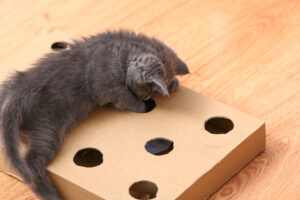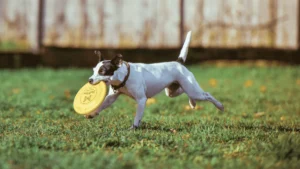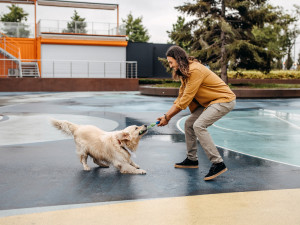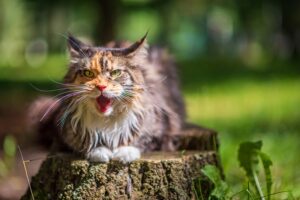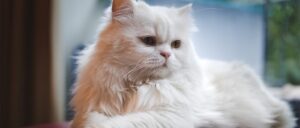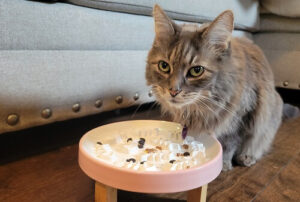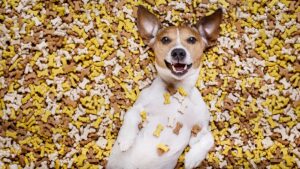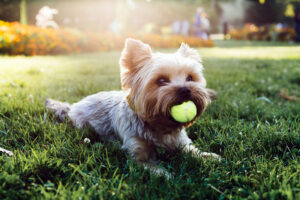________
Making DIY Toys For Pets
Our pet’s playtime is crucial to the health of both their body and mind. Making DIY toys for pets is a fun and creative way to bond with your four-legged pals while also providing them with hours of enjoyment. These one-of-a-kind items, from games to feather wands, are designed to satisfy your pet’s innate curiosity while strengthening the bond between you and your furry friend.
Puzzle Toys

Pets, just like us, greatly benefit from mental challenge and problem-solving in the form of challenging puzzles and games.
Treat-dispensing interactive puzzle toys are a fun way to test your pet’s intelligence while also encouraging positive behaviors.
- DIY puzzle toys can be made from any box or container with a lid.
- Create access to the delicacies within by cutting holes in the covers. Put some food or treats in the container, and let your pet figure out how to get them.
- This serves multiple purposes, including providing mental stimulation and warding off boredom-related bingeing.
You may tailor the puzzle’s challenge to your pet’s skill level. To keep them interested and puzzled as they progress in skill, you can tweak and improve the design.
Rope Toys for Dogs

Chewing and tug-of-war games are two of a dog’s favorite activities. Making your own rope toys is a great way to redirect their energy and have fun while doing it.
- Produce braided toys that are simple to hold and chew using all-natural, non-toxic materials like cotton rope.
- Depending on your dog’s preferences, you can try out different knot patterns and sizes.
- Make sure the rope is well braided and free of any slack that could cause suffocation.
Chewing on the rope prevents plaque and tartar from accumulating in the teeth.
Tug-of-war activities with the rope toy are great for your dog’s physical health and for strengthening your bond with your canine companion.
Feather Wands and Laser Pointers for Cats

Our feline friends can’t be truly happy or pleased until they are able to indulge their natural hunting impulses. Feather wands and laser pointers that you make yourself are fascinating ways to play with your cat.
- Feathers and a thread or bendable stick are all you need to make a wand.
- Feathers should move to attract cats, and when they swat at them, it will remind them of hunting.
Your cat will greatly benefit from the physical exercise and the opportunity to engage in natural behaviors in a fun and safe setting that this form of play affords.
Cats can also have fun with laser pointers, which are a common interactive toy. The flickering light simulates the actions of small prey, arousing your cat’s natural hunting instincts.
Caution: Never point the laser at your cat’s eyes, since this could cause permanent damage
Cardboard Caves for Cats

Cats are well-known for their curious nature and penchant for finding new places to hide. Cardboard caves are an easy and inexpensive way to satisfy this feline passion.
- Collect a wide range of cardboard box sizes and shapes.
- Create passageways and storage areas by cutting holes in the boxes at regular intervals.
- In order to avoid injury, the cardboard’s edges should be smooth and unbroken.
- Cat-friendly patterns and themes can be used to further customize the hiding places.
These nooks are perfect for your feline friend to investigate, play in, and rest in. Cardboard’s rough surface is ideal for scratching, promoting healthy claws, and reducing the risk of damage to your furniture.
Tips for Successful DIY Pet Projects
DIY pet projects are fun and educational for you and your furry friend. Crafting your pet’s own unique accessories and toys can be a lot of fun, but before you get started, there are a few things you should know to make sure your pet is safe, happy, and healthy.
Incorporating these principles into your DIY pet projects can ensure that the final products are both useful and enjoyable for your pet.

- Prioritize Your Pet’s Health and Safety
When making DIY toys for pets, you should always put their safety first.
- Select components that are harmless to your pet’s health and won’t cause any allergic reactions.
- Pets typically investigate new objects by putting them in their mouths, so it’s best to steer clear of anything toxic that they could eat.
- Make sure any decorations or embellishments you use aren’t readily chewed off and swallowed if you want to use them.
- If you have a little pet or one that likes to chew, you should be extra wary of toys with small, removable elements that could present a choking hazard.
- Choose High-Quality and Long-Lasting Materials
The durability and security of the things you make depend on your material choices. Pick high-quality, long-lasting materials that can handle your pet’s rough play style.
- Fabrics made from natural materials like cotton, hemp, or fleece are ideal because they are soft on your pet’s skin and won’t harm them in any way.
- Choose organic colors and paints that won’t off-gas dangerous chemicals when decorating with pets.
- Don’t use anything if there’s a chance it could irritate your pet or if you have allergies.
- In addition, if you plan on using adhesives, double check that they are safe for your pet and will effectively bond the materials.
- Proportions and Measurements
Your pet may feel uncomfortable or possibly be put in danger by objects that are too big or too small for them. Make sure the DIY toys for pets are in the right measurements for your pet. A toy that is too small for your dog could cause choking, while DIY accessories that are too large could restrict your pet’s movement or cause discomfort.
- Make sure your pet’s collar or harness fits properly so it doesn’t restrict movement or cause skin irritation.
- Think about how your pet grips, chews, and plays with toys.
- It’s better to overestimate the item’s size and compatibility than underestimate it when introducing it to your pet.
- Make Your Pets Happy with Tactile Stimulation
Making DIY toys for pets that stimulate your pet’s senses and interest them is a rewarding aspect of DIY pet projects. Tactile stimulation can be achieved by the use of a variety of textures, including but not limited to smooth surfaces, soft textiles, and crinkly materials.
- To create visual and auditory appeal that catches your pet’s attention, consider giving toys with bells, squeakers, or rattles.
- Use natural scents like lavender or catnip to pique your dog’s or cat’s interest, and vice versa.
Your pet will be more engaged and have more fun during playtime with sensory-rich accessories and toys because they are satisfying their natural impulses.
- Always Ensure Safety Through Supervision
Even if you made these items with your pet’s delight in mind, you still need to keep an eye on them while they play.
- Keep an eye on your pet’s behavior as you introduce him or her to new toys or accessories.
- You can gauge their reaction and make sure the toys are suitable for their age and preferred method of play by letting them try them out first.
- Check the condition of your pet’s toys and accessories on a consistent basis. Things wear out, lose their strength, or come loose with time, posing hazards to your pet.
- Maintain a risk-free recreational space by fixing or replacing damaged components immediately.
- Customize Your DIY Pet Projects
The individuality of each pet is reflected in its individual tastes and habits. Keep an eye on how your pet uses your creations and be willing to make changes based on their suggestions. Some animals are more interested in particular sorts of play, while others have a preference for particular textures.
- Keep an eye on how your pet responds and modify your DIY project plans accordingly.
- This customization not only increases your pet’s satisfaction but also strengthens your relationship with them as you meet their specific demands.
FAQs
Why should I try making DIY pet projects?
DIY accessories and toys for your pets are a great way to bond, show them you care, and have fun while doing something productive and creative. You may save money, help the environment, and exercise your imagination all at the same time with one of these projects.
How can I use DIY pet projects to strengthen my bond with my pet?
Making DIY accessories and toys for your pets reflects your attention to their individuality and requirements. It is a great way to strengthen your bond with them. The emotional connection you share with your animal buddy will grow as a result of the time, effort, and love you put into crafting for them.
What kinds of pets can benefit from DIY projects?
All sorts of animals, from canines and felines to birds, bunnies, and even small rodents, can benefit from your DIY pet projects. The trick is to learn your pet’s unique wants, needs, and habits, then adapt your work to suit them.
How can I know if the DIY projects I make are secure for my pet?
Make safety a top priority by selecting materials that are safe for pets. Choose eco-friendly materials like wool and cotton and organic paints and dyes. All decorative features should be securely fastened, and small, removable portions should be avoided to prevent choking.
Can you recommend some DIY accessories for pets?
Collars, leashes, beds, blankets, clothes, and feeding stations can all be made to order. These items are great for your pet’s comfort and also show off their unique individuality.
When making homemade DIY accessories for pets, how do I determine the appropriate dimensions?
Consider your pet’s breed, size, and comfort level while making your selection. Overly large or small items might cause discomfort or restrict movement, respectively. To avoid any pain or safety concerns, make sure you measure your pet correctly.
What positive effects might DIY toys for pets have on my pet’s health and happiness?
DIY toys for pets, including puzzles and toys you can climb on, are great for your pet’s development. These playthings satisfy your pet’s innate drives, stave off boredom, and improve their well-being.
How can I make sure the DIY projects I make for my cats won’t hurt them?
Always put safety first while making DIY toys for pets. Materials should be natural, non-toxic, and durable enough to endure your pet’s rough playstyle. Don’t use anything that could break off and pose a choking danger. Toys should be checked for damage and replaced on a regular basis.
How can I make DIY toys for pets more interesting and engaging?
You may make toys that your pet enjoys more by paying attention to how they play with the ones you make for them. See how your pet responds before making any permanent changes to the colors, shapes, or interactivity. Toys that are special to pets increase their interest in and satisfaction from play.
What are some additional tips for completing DIY pet projects successfully?
Don’t forget to engage the senses by mixing up the textures and aromas. When playing with a new toy, always keep an eye on your pet. Don’t be afraid to make changes or additions if your pet suggests it. Last but not least, have fun making things and watching your pet have fun with them.
Conclusion
DIY pet projects are a satisfying way to exercise your ingenuity while also improving your pet’s quality of life. By learning your pet’s likes and dislikes, you may make him or her unique accessories and toys that will bring you both comfort and pleasure. DIY projects for pets require careful planning, original thinking, and an in-depth familiarity with your furry friend’s individual needs. Put in some elbow grease, round up some supplies, and go out on a voyage of making precious memories with your beloved friends.


























